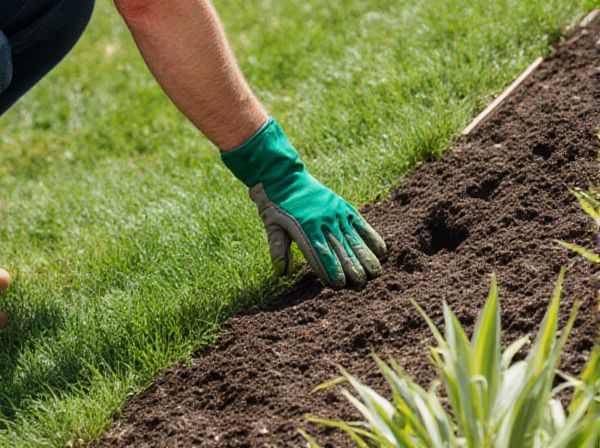
Sloped Landscaping vs Flat Landscaping Illustration
Sloped landscaping presents unique challenges and opportunities, requiring erosion control methods and strategic plant selection to stabilize the terrain and enhance visual interest. In contrast, flat landscaping offers easier maintenance, straightforward irrigation, and versatile design options suitable for lawns, gardens, and recreational spaces. Choosing between sloped and flat landscaping depends on site topography, functional needs, and aesthetic preferences to create a balanced outdoor environment.
Table of Comparison
| Aspect | Sloped Landscaping | Flat Landscaping |
|---|---|---|
| Design Complexity | Higher complexity due to elevation changes | Simple, easy to design and implement |
| Drainage | Natural water runoff, needs erosion control | Requires artificial drainage systems |
| Maintenance | Challenging, risk of soil erosion | Easier, regular lawn care |
| Space Utilization | Less usable flat area, creative planting needed | Maximizes usable flat space |
| Cost | Higher due to grading and erosion control | Lower, minimal grading required |
| Aesthetic Appeal | Adds visual interest and dimension | Classic, clean look |
| Safety | Potential slip hazards, requires careful planning | Safer for children and elderly |
Understanding Sloped vs Flat Landscaping
Sloped landscaping offers natural drainage benefits and creates visual interest through elevation changes, making it ideal for properties with uneven terrain. Flat landscaping provides easier maintenance and maximizes usable space, often preferred for patios, lawn areas, and outdoor activities. Understanding the advantages and challenges of sloped versus flat landscaping helps homeowners choose the best design for functionality and aesthetic appeal.
Key Design Principles for Sloped and Flat Yards
Sloped landscaping requires careful consideration of erosion control, drainage solutions, and terracing to create functional and visually appealing outdoor spaces. Flat landscaping emphasizes uniform water distribution, seamless lawn integration, and strategic plant placement to maintain balance and ease of maintenance. Both designs prioritize soil stability, appropriate plant selection, and efficient water management to enhance yard sustainability and aesthetic value.
Drainage Solutions: Slope vs Flat Landscapes
Sloped landscaping naturally facilitates water runoff, reducing the risk of water pooling and soil erosion by directing drainage away from structures. Flat landscaping requires engineered drainage solutions such as French drains, swales, or grading to prevent water accumulation and promote efficient water flow. Properly designed slope gradients optimize drainage efficiency while minimizing landscape damage and maintenance needs.
Plant Selection for Slopes and Level Gardens
Plants for sloped landscaping must have strong root systems to prevent soil erosion, with options like creeping juniper, daylilies, and ornamental grasses being highly effective. In level gardens, a wider variety of plants thrive, including delicate perennials, shrubs, and vegetable gardens that require stable, even soil conditions for optimal growth. Selecting drought-tolerant species for slopes helps reduce water runoff, while flat areas support moisture-loving plants due to consistent soil retention.
Erosion Control Strategies for Sloped Areas
Sloped landscaping requires targeted erosion control strategies such as terracing, retaining walls, and the use of deep-rooted ground covers to stabilize soil and reduce runoff. Installing drainage systems like French drains or swales helps manage water flow and prevent soil displacement. Incorporating mulch and erosion control blankets further protects slopes by minimizing surface erosion during heavy rainfall.
Accessibility and Usability: Pros and Cons
Sloped landscaping often enhances natural drainage and creates visually dynamic spaces but can pose accessibility challenges for individuals with mobility issues, requiring ramps or terraced steps to improve usability. Flat landscaping offers straightforward access and ease of movement, making it ideal for wheelchair users and children, though it may struggle with water runoff and erosion if not properly engineered. Choosing between sloped and flat designs depends on balancing aesthetic preferences with practical accessibility needs and site-specific environmental factors.
Hardscaping Ideas: Retaining Walls vs Patios
Retaining walls in sloped landscaping provide essential soil stabilization while creating tiered garden spaces that enhance visual appeal and prevent erosion. Patios are ideal for flat landscaping, offering expansive, functional outdoor living areas perfect for entertaining and relaxation. Incorporating natural stone or concrete materials in both retaining walls and patios boosts durability and complements the surrounding landscape's aesthetic.
Maintenance Differences: Slope vs Flat
Sloped landscaping requires more frequent erosion control measures and careful drainage management to prevent soil runoff, whereas flat landscaping typically involves straightforward mowing and irrigation routines. Steeper slopes demand specialized equipment for mowing and trimming, increasing maintenance time and labor compared to flat areas. Flat landscapes offer easier access for routine upkeep, reducing the risk of accidents and allowing for more consistent plant care.
Cost Comparison: Sloped vs Flat Landscaping
Sloped landscaping generally incurs higher costs than flat landscaping due to the need for specialized erosion control measures, terracing, and drainage systems. Flat landscaping projects typically require less grading and fewer structural reinforcements, resulting in lower labor and material expenses. Budgeting for sloped landscapes must also consider long-term maintenance costs associated with soil stabilization and water runoff management.
Long-term Aesthetics and Value Considerations
Sloped landscaping offers natural drainage benefits and creates dynamic visual interest through tiered plantings and retaining walls, enhancing long-term curb appeal and property value. Flat landscaping provides versatile space for functional outdoor living areas like patios and gardens, maintaining ease of maintenance and adaptability over time. Homeowners should weigh slope stabilization costs against flat yard usability to maximize aesthetic longevity and investment returns.
Sloped Landscaping vs Flat Landscaping Infographic

 gardendif.com
gardendif.com